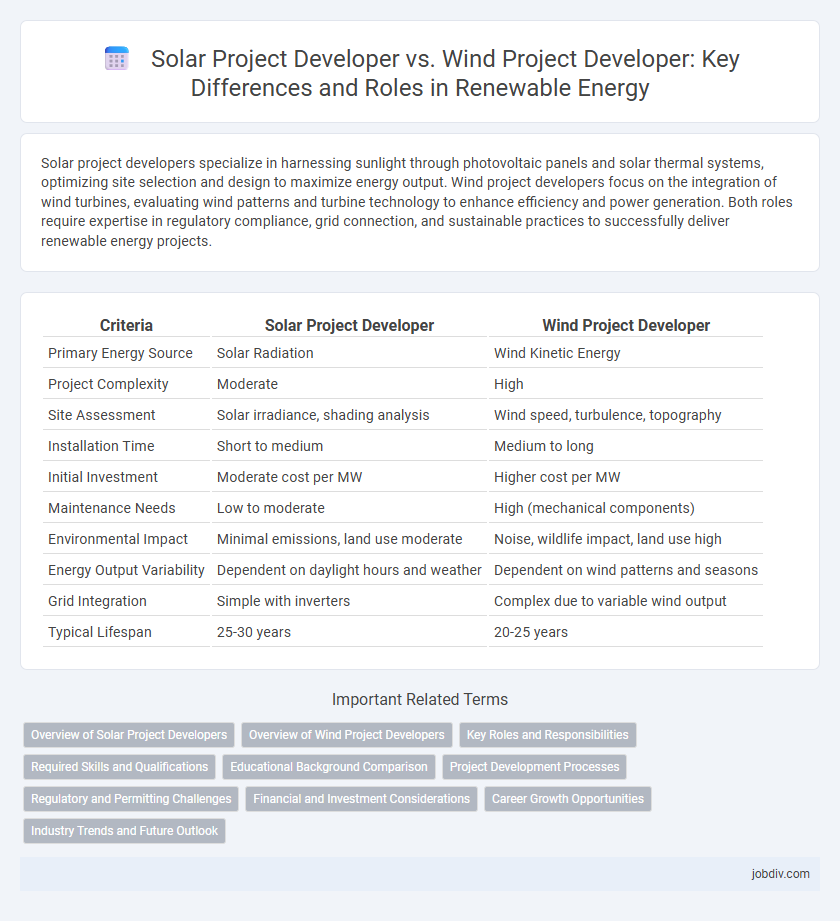Solar project developers specialize in harnessing sunlight through photovoltaic panels and solar thermal systems, optimizing site selection and design to maximize energy output. Wind project developers focus on the integration of wind turbines, evaluating wind patterns and turbine technology to enhance efficiency and power generation. Both roles require expertise in regulatory compliance, grid connection, and sustainable practices to successfully deliver renewable energy projects.
Table of Comparison
| Criteria | Solar Project Developer | Wind Project Developer |
|---|---|---|
| Primary Energy Source | Solar Radiation | Wind Kinetic Energy |
| Project Complexity | Moderate | High |
| Site Assessment | Solar irradiance, shading analysis | Wind speed, turbulence, topography |
| Installation Time | Short to medium | Medium to long |
| Initial Investment | Moderate cost per MW | Higher cost per MW |
| Maintenance Needs | Low to moderate | High (mechanical components) |
| Environmental Impact | Minimal emissions, land use moderate | Noise, wildlife impact, land use high |
| Energy Output Variability | Dependent on daylight hours and weather | Dependent on wind patterns and seasons |
| Grid Integration | Simple with inverters | Complex due to variable wind output |
| Typical Lifespan | 25-30 years | 20-25 years |
Overview of Solar Project Developers
Solar project developers specialize in harnessing photovoltaic technology to design, finance, and construct solar energy systems that convert sunlight into electricity, often focusing on utility-scale and distributed solar installations. Their expertise includes site assessment, securing permits, technology selection, and integration with grid infrastructure to maximize energy yield and cost efficiency. Solar developers contribute significantly to renewable energy targets by driving rapid deployment and innovation in solar panel efficiency and energy storage solutions.
Overview of Wind Project Developers
Wind project developers specialize in the planning, financing, and construction of wind energy facilities, leveraging advanced turbine technology to harness wind power efficiently. These developers focus on site assessment, environmental impact analysis, and grid integration to optimize energy production from onshore and offshore wind farms. Leading companies in this sector include Vestas, Siemens Gamesa, and GE Renewable Energy, which drive innovation and scalability in the global wind market.
Key Roles and Responsibilities
Solar project developers specialize in site assessment, permitting, and managing photovoltaic panel installation to optimize solar energy capture, while wind project developers focus on wind resource analysis, turbine selection, and grid integration for efficient electricity generation. Both roles require stakeholder coordination, financial planning, and adherence to regulatory frameworks to ensure project viability and sustainability. Effective project management and technical expertise are critical in advancing renewable energy infrastructure within their respective sectors.
Required Skills and Qualifications
Solar project developers require expertise in photovoltaic technology, solar resource assessment, and electrical engineering, along with knowledge of local regulations and permitting processes. Wind project developers must possess skills in aerodynamic analysis, meteorology, turbine technology, and environmental impact assessments, as well as experience with grid integration and site logistics. Both roles demand strong project management capabilities, financial modeling expertise, and familiarity with renewable energy policies and incentives.
Educational Background Comparison
Solar project developers often have educational backgrounds in electrical engineering, renewable energy technology, or environmental science, emphasizing photovoltaic systems and solar energy conversion. Wind project developers typically hold degrees in mechanical or aerospace engineering, atmospheric sciences, or environmental engineering, focusing on wind turbine technology and aerodynamic performance. Both fields value expertise in project management and sustainable energy systems, but their specialized knowledge reflects the distinct technical and environmental requirements of solar versus wind energy projects.
Project Development Processes
Solar project developers focus on site assessment, solar irradiance analysis, and photovoltaic system design, emphasizing panel placement and inverter selection to optimize energy capture. Wind project developers prioritize wind resource assessment, turbine selection, and foundation engineering, addressing variable wind patterns and land topography for maximal output. Both require permitting, environmental impact studies, and grid integration planning, but technical specifics differ due to resource variability and technology constraints.
Regulatory and Permitting Challenges
Solar project developers often face complex regulatory hurdles related to land use, environmental impact assessments, and grid interconnection standards that vary significantly between jurisdictions. Wind project developers encounter stringent permitting processes focused on wildlife protection, noise regulations, and setback requirements to minimize community and ecological disruptions. Both sectors require comprehensive stakeholder engagement and adaptive strategies to navigate evolving policies and ensure compliance throughout project lifecycles.
Financial and Investment Considerations
Solar project developers typically benefit from lower capital expenditure and faster return on investment due to declining photovoltaic panel costs and simpler installation processes. Wind project developers often face higher upfront costs related to turbine manufacturing, transportation, and site-specific construction challenges, but they may secure long-term revenue through power purchase agreements and incentives linked to onshore and offshore wind capacity. Investment decisions hinge on factors such as regional resource availability, government subsidies, maintenance costs, and forecasted energy yield, which collectively influence project financing structures and risk assessments.
Career Growth Opportunities
Solar project developers benefit from rapid industry expansion driven by declining photovoltaic costs and government incentives, offering abundant opportunities for career advancement in project management, technology innovation, and sustainability consulting. Wind project developers experience steady growth in offshore and onshore installations, providing specialized roles in turbine technology, site assessment, and regulatory compliance. Both sectors value expertise in renewable energy policy, finance, and environmental impact, making them competitive fields with diverse paths for professional development.
Industry Trends and Future Outlook
Solar project developers are rapidly expanding due to declining photovoltaic costs and increasing government incentives, driving widespread adoption in residential and commercial sectors. Wind project developers benefit from advancements in turbine technology and offshore wind potential, enabling larger capacity installations and reduced levelized cost of energy (LCOE). Industry trends indicate a hybrid approach combining solar and wind assets to maximize energy yield and grid stability, with future outlook favoring integrated renewable portfolios supported by smart grid innovations.
Solar Project Developer vs Wind Project Developer Infographic

 jobdiv.com
jobdiv.com